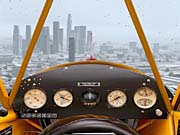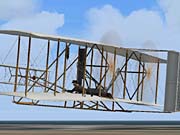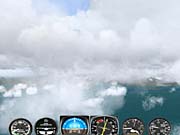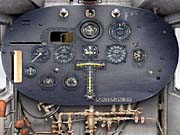Microsoft Flight Simulator 2004: A Century of Flight Preview
We take a first-hand look at what's new in the next major update to Microsoft's long-running civilian flight simulation.
Like it or not, Microsoft's Flight Simulator series cornered the market for PC civilian flight simulations quite some time ago. These days, older contenders such as Terminal Reality's Fly! and Looking Glass' Flight Unlimited seem like nothing but distant specks disappearing over the horizon--and there is simply no other serious alternative. Fortunately, judging from what we've seen, Microsoft doesn't seem content to rest on its laurels.

Early this summer, the software giant will release the most impressive version of Flight Simulator to date. The release of Microsoft Flight Simulator 2004: A Century of Flight will coincide with both the 100th anniversary of powered flight and the 20th anniversary of this respected series. And if the version we played is any indication, it may offer the most comprehensive and believable civilian flight experience in any PC game to date. Just check the numbers: For instance, Microsoft has upped the number of operable airports from 22,000 to an even more impressive 24,000. More importantly, the company has increased the number of flyable aircraft by nine, from 15 to 24. And these aren't just any old aircraft, either. With Flight Simulator 2004, Microsoft will attempt to chronicle and celebrate the beginnings of our love affair with modern-day airborne transportation.
Those who want to take this flying thing all the way back to its rickety beginnings will undoubtedly enjoy a hazardous spin in a real original--the Wright brothers' famed Kitty Hawk contraption, the Wright Flyer. The game will also let you try out Charles Lindbergh's "The Spirit of St. Louis" or Amelia Earhart's Lockheed Vega. There are more relics where these came from, including the infamous World War I bomber-turned-long-distance-traveler, the Vickers Vimy, the relatively sophisticated Douglas DC-3 passenger airliner, and the thrilling little Piper Cub. Add in a cast of returning craft that includes contemporary Beechcrafts, massive Boeing passenger jets, a flock of Cessnas, and a couple of choppers, and you have a truly impressive list of flyable aircraft.
Yet raw numbers don't even begin to tell the story. If what we've seen is any indication, the game's presentation will be even more impressive than the sheer number of new airports and aircraft. Those new aircraft, for example, are modeled with incredible accuracy. Take a seat in the infamous Spirit of St. Louis, and you'll soon realize Lindbergh was far more than just lucky. Almost uncontrollable and frighteningly shaky, the simplistic little machine he flew over North America and then across the Atlantic would have bested many men. In fact, with a large front-mounted fuel tank obscuring his line of sight, Lindy couldn't even see where he was going without first extending a retractable periscope. And nor will you, unless of course you press the W key on your keyboard and magically open your field of vision. One click and you'll eliminate the entire cockpit, except for the most important gauges, which sit conveniently across the base of the monitor screen. Another click and you'll remove those gauges too, for a completely unfettered perspective.
Indeed, with various single-click difficulty adjustments, a variety of intricate customizations, a broad range of tutorial material, and plenty of pilot's aids, Flight Simulator 2004 may be the most accessible Flight Simulator ever. Even complete beginners will once again benefit from a series of helpful introductory videos hosted by real-life flying educators John and Martha King. Rookies and veterans alike will get even more information and experience in the game's flight lessons component, wherein Flight Simulator's resident guru Rod Machado returns to take trainees on two dozen in-depth textual and hands-on exercises ranging from basic skills to advanced airline transport pilot instruction.

More good news will come in the form of Flight Simulator's new learning center. Here, users may access the game's e-manual and other associated options, all displayed and catalogued inside an attractive and comprehensive Web page-style format. Dream up a pertinent subject and chances are it's addressed within the learning center, from helicopter and jet guidelines to kneeboard and GPS instruction and even hardware controller and graphic optimization advice. Indeed, the learning center comes far closer than most virtual guides to making the absence of a printed manual quite palatable. In many ways, it goes much farther than a hard-copy booklet ever could.
More Flying Machines

Those with a taste for history will really appreciate the game's treatment of its classic aircraft. Not only will pilots have a chance to fly these ancient marvels, but they may do so by following the flight paths that made them famous. You'll be able to engage in quick jaunts at Kitty Hawk, daunting transatlantic journeys, and triple-continent 11,000-mile marathons. The version we played didn't actually re-create contemporary scenery, nor did it model details such as the deliberate wing-warping of the Wright Flyer or even the fiery results of a crash. However, the game will provide a rather startling lesson on how challenging it must have been just to get some of these curiosities off the ground, as well as thorough text accounts and video glimpses of each celebrated machine.
But the game's revamped presentation is most dramatic when you've finally taken your place in the cockpit and had a chance to look around. Whether you like your weather sunny and warm, snowy and cold, or completely variable, Flight Simulator 2004's portrayal of ambient conditions will be very impressive indeed. For starters, the game will let you choose either fixed, variable, or real-world weather. The real-world option receives automatic online updates every 15 minutes from Jeppeson flight information services. For example, we tried playing the game on a rainy day, and after taking off from a local airport in the game, we watched the game's skies darken and rain begin to fall within about 30 minutes.
If the sheer variety of prevailing conditions isn't enough, the way they look may very well be. Clouds form and move and dissipate or merge with others to suddenly fill the skies with an opaque blanket, all right in front of your eyes. Clouds also sport varying degrees of density and shading, manifesting themselves as a semitranslucent haze, a thick whiteout or grayout, or any number of middle-ground combinations. Rain and snow pound on the windshield as you soar through the air. In clear conditions, you may find yourself staring into blinding sun glare. Lightning strikes rip through the skies, and thunder rolls through the speakers with a distant growl or a startling explosion.
Flight Simulator has evolved nicely in other areas too. On the ground, geographical features such as rivers are rendered in far more credible fashion, even when situated in the middle of nowhere. We checked out several spots where we'd found graphical anomalies in previous versions and came away feeling that Microsoft has put in some serious time cleaning things up. And, whether your selected airstrips are of the major or minor variety, you can expect to find more detail, more signage, and a far greater number of visual perks.

You'll find substantially more AI traffic too, on the ground and in the air and even at nontowered airports. Furthermore, new traffic control features allow you to request flight plan changes on the fly. Now, you can begin a VFR flight and change to an IFR flight plan while airborne. You can request different landing approaches, different runways, and nonprecision approaches. Additionally, the game's new and improved GPS modules (based on the Garmin 500 and 295 real-world units) are much more functional, handling just about anything their real-life counterparts can handle.
There is, however, a price to pay for all these improvements and upgrades. The hardware requirements are a couple of steps higher than with previous game. During our test flights, we noticed our 1.4GHz-equipped computer laboring just to maintain a workable frame rate. To attain truly smooth visuals, we had to reduce the detail levels quite a bit at 1024x768.
If civilian flight is your passion, there's just one game in town, at least for now. Luckily for budding pilots everywhere, it seems like it'll be a good one. The latest version of Microsoft Flight Simulator takes to the skies this July.
Got a news tip or want to contact us directly? Email news@gamespot.com
Join the conversation